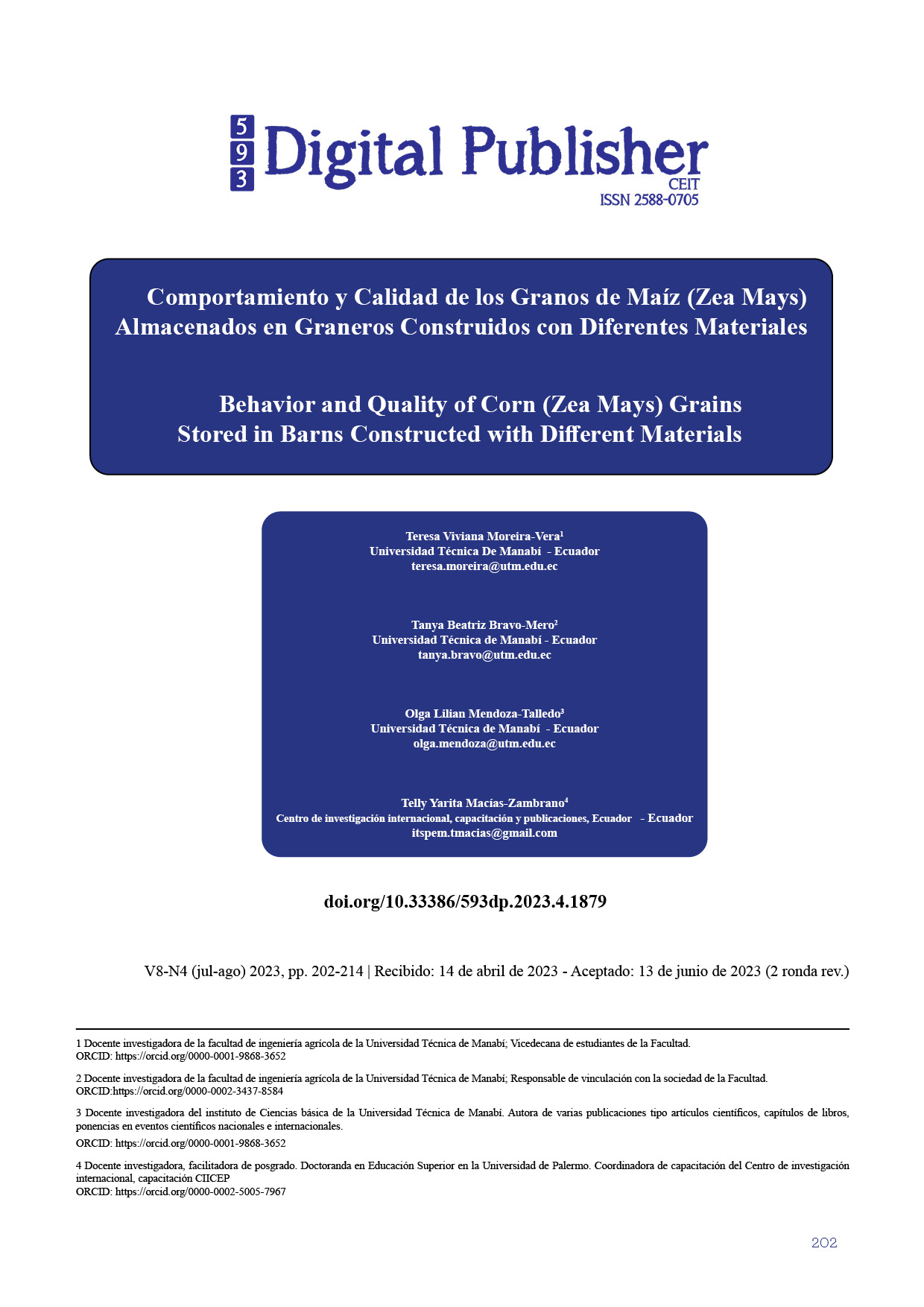Behavior and Quality of Corn (Zea Mays) Grains Stored in Barns Constructed with Different Materials
Main Article Content
Abstract
Maize is the oldest known food grain in the world; it is the only cultivated species of this genus that constitutes a very nutritious and accessible food for people, however, one of the conditions for its prolonged conservation is storage at temperatures between 20-24◦C maximum.
The study describes the behavior of temperature and humidity in the conservation of corn grains stored in barns with materials from the environment, in the Mapasingue community of Ecuador; two experimental models were designed that simulated two barns with different materials, one for control and the other for treatment, using a sample of 1000 grains collected for six weeks, temperature and humidity were measured in each prototype, starting with a temperature of 23◦C and humidity of 15% in treatment and control, the duration of the trial was 45 days. In the case of the treatment, the mean showed minimum and maximum values of 12 and 13% humidity respectively; temperature remaining constant throughout the storage period in the experiment.
The moisture percentages of the treatment were lower than those of the control; the difference between the damaged grains of the treatment and the control was 9.6%, taking as a sample 46 kilograms of corn in the treatment, the treatment being profitable, and from the total of damaged grains the cost of the same was determined, the value of which was US$4.81. The importance of pretreatment of grains before storage in barns made of wood and metal is concluded.
Downloads
Article Details

This work is licensed under a Creative Commons Attribution-NonCommercial-ShareAlike 4.0 International License.
1. Derechos de autor
Las obras que se publican en 593 Digital Publisher CEIT están sujetas a los siguientes términos:
1.1. 593 Digital Publisher CEIT, conserva los derechos patrimoniales (copyright) de las obras publicadas, favorece y permite la reutilización de las mismas bajo la licencia Licencia Creative Commons 4.0 de Reconocimiento-NoComercial-CompartirIgual 4.0, por lo cual se pueden copiar, usar, difundir, transmitir y exponer públicamente, siempre que:
1.1.a. Se cite la autoría y fuente original de su publicación (revista, editorial, URL).
1.1.b. No se usen para fines comerciales u onerosos.
1.1.c. Se mencione la existencia y especificaciones de esta licencia de uso.
References
Guamán, R., Desiderio, T., Villavicencio, A., Ulloa, S., & Romero, E. (2020). Evaluación del desarrollo y rendimiento del cultivo de maíz (Zea maysL.) utilizando cuatro híbridos. Siembra. Siembra, 7(2), 47-56. doi:https://doi.org/10.29166/siembra.v7i2
Alcívar, J., Giler, L., Sancán, D., & Menoscal, G. (2021). The monoculture of corn (zea mayz) and its impact on fertility soil. International Journal of Chemical & Material Sciences, 4(1), 7-12. doi:https://doi.org/10.31295/ijcms.v4n1.1649
Bernadette, A., & y Bartosik, R. (2013). Manual de Buenas Prácticas en Poscosecha de Granos. INTA. Obtenido de https://inta.gob.ar/sites/default/files/inta_manual_de_buenas_practicas_en_poscosecha_de_granos_reglon_48-2.pdf
Blanco, Y., & y Leyva, Á. (2010). “Abundancia y diversidad de especies de arvenses en el cultivo de maíz (Zea mays,L.) precedido de un barbecho transitorio después de la papa (Solanum tuberosum L.). Cultivos Tropicales, 31(2), 11-17. Obtenido de http://scielo.sld.cu/scielo.php?script=sci_arttext&pid=S0258-59362010000200002
Blanco, Y., Durañona, H., & Acosta, R. (2016). The effect of temperature and humidity on maize grains conservation in metal silos. Cultivos Tropicales, 37(4), 105-114. doi:http:dx.doi.org/10.13140/RG.2.2.13900.21127
Cardoso, M., Rodríguez, J., De la Torre, D., & Casini, C. (2016). Poscosecha campaña 2015/2016: Almacenamiento de Soja y Maíz, en un contexto de alta humedad. INTA. Obtenido de https://inta.gob.ar/sites/default/files/intaalmacenamiento-de-soja-y-maiz-en-un-contexto-de-alta-humedad.pdf
Caviedes, M., Carvajal, F., & Zambrano, J. (2022). Tecnologías para el cultivo de maíz (Zea mays. L) en Ecuador. ACI Avances en ciencias e ingenierías, 14(1), 1-21. doi:https://doi.org/10.18272/aci.v14i1.2588
Corcuera, V., Salmoral, E., Pennisi, M., Kandus, M., & Salerno, J. (2016). Análisis composicional cuanti-cualitativo de los macronutrientes del grano de híbridos de maíz con valor mejorado (VEC) desarrollados para la industria alimentaria argentina. Revista de Divulgación Técnica Agropecuaria, Agroindustrial y Ambiental Facultad de Ciencias Agrarias. UNLZ. 3 (2), 37-51. Obtenido de http://revistafcaunlz.gramaweb.com.ar/wp-content/uploads/2016/06/Corcuera_et_al.pdf
Eyhérabide, G. (2010). Bases para el Manejo del Cultivo de Maíz. INTA. Obtenido de https://inta.gob.ar/sites/default/files/inta_bases_para_el_manejo_de_maiz_reglon_100-2_2.pdf
FAO. (07 de abril de 2023). fao.org. Obtenido de El comercio mundial de cereales en 2022/23 se sigue revisando a la baja; el pronóstico sobre la producción mundial de trigo en 2023 aumenta ligeramente respecto del mes pasado: https://www.fao.org/worldfoodsituation/csdb/es/
Feitó, M., Martínez, G., Covas, D., & Barrera, A. (2015). Control de la temperatura para la prevención de plagas poscosecha en la conservación de granos. Ingeniería y Desarrollo, 33(2), 216-237. Obtenido de https://www.redalyc.org/pdf/852/85241628005.pdf
Ferraz, Y., Permuy, N., & Acosta, R. (2013). Evaluación de accesiones de maíz (Zea mays, L.) en condiciones de sequía en dos zonas edafoclimáticas del municipio Gibara, provincia Holguín. Evaluación morfoagronómica y estudios de la Interacción genotipo x ambiente . Cultivos Tropicales, 34(4), 24-30. Obtenido de http://scielo.sld.cu/pdf/ctr/v34n4/ctr04413.pdf
Hernández, C., Rodríguez, Y., & Niño, Z. y. (2009). Efecto del Almacenamiento de Granos de Maíz (Zea mays) sobre la Calidad del Aceite Extraído. Información Tecnológica, 20(4), 21-30. doi:http://doi.org/10.4067/S0718-07642009000400004
Loayza, L. (2020). Comportamiento morfológico y agronómico de diferentes cultivares de maíz. Universidad Técnica de Machala. Obtenido de http://repositorio.utmachala.edu.ec/bitstream/48000/16139/1/TTUACA-2020-IA-DE00022.pdf
Macías, T. (2021). Una visión ancestral a los saberes montuvios de la campina manabita. Experiencias, parte I. Portoviejo: Grupo Compas. Obtenido de http://142.93.18.15:8080/jspui/handle/123456789/725
Manuel, I., Gil, A. .., Ramírez, V., Hernández, H., & Bellon, M. (2007). Calidad física y fisiológica de semilla de maíz criollo almacenada en silo metálico y con métodos tradicionales en Oaxaca, México. Fitotecnia Mexicana, 30(1), 69-78. Obtenido de https://www.redalyc.org/pdf/610/61030109.pdf
Meneghello, G. (27 de marzo de 2017). Control de temperatura y humedad del grano almacenado. Obtenido de elproductor.com: https://elproductor.com/2017/03/control-de-temperatura-y-humedad-del-grano-almacenado/
Paliwal, R. (12 de Enero de 2023). Introduccion al maiz y su importancia. Obtenido de fao.org: https://www.fao.org/3/x7650s/x7650s02.htm
Rodríguez, J., Ávila, M., Gámez, F., De la O, M., & Gámez, A. (2018). Calidad física y fisológica de semilla de maíz influenciada por el patrón de siembra de progenitores. Revista Fitotecnia Mexicana, 41 (1), 31 - 37. Obtenido de https://www.scielo.org.mx/pdf/rfm/v41n1/0187-7380-rfm-41-01-31.pdf
Sánchez, I., & y Pérez, E. (2014). Maíz I (Zea mays). Reduca (Biología). Serie Botánica. 7 (2), 151-171. Obtenido de https://eprints.ucm.es/id/eprint/27974/1/MAIZ%20I.pdf
Vásquez, M., Preciado, R., Santiago, D., Palacios, N., Terrón, A., & Hernández, A. (2018). Estabilidad del rendimiento y calidad del grano y tortilla de nuevos híbridos de maíz con valor agregado para el subtrópico de México. Revista Fitotecnia Mexicana, 41(4A), 509-518. Obtenido de https://www.scielo.org.mx/pdf/rfm/v41n4a/0187-7380-rfm-41-4a-509.pdf
Zambrano, C., & y Andrade, M. (2021). Productividad y precios de maíz duro pre y post COVID-19 en el Ecuador. Revista Universidad y Sociedad, 13(4), 143-150. Obtenido de http://scielo.sld.cu/pdf/rus/v13n4/2218-3620-rus-13-04-143.pdf





